"Carburetor icing" over the Hump possible?
Fri Apr 29, 2016 4:40 pm
I'm working on an article for Military History Quarterly magazine about the famous trans-Himalaya airlift between India and China during World War II, and I keep coming across references to Curtiss C-46s, with P&W R2800 engines, suffering "carburetor icing" while flying the route.
Keeping in mind the fact that cruising altitudes typically were between 15,000 and 20,000 feet for C-46s, and that OAT was almost certainly well below 0 degrees F., it's my assumption that what is meant by "carburetor icing" was actually impact icing, which would affect the engine's induction air rather than the carburetor venturi. The remedy would be activating alternate air, not carburetor heat. (I have flown a variety of single-, twin- and four-engine piston aircraft and have never experienced carb ice in anything but carbureted low-altitude singles.)
Am I right, or is it possible that there actually was such a thing a carburetor icing at so low a temperature? This carburetor-ice canard, if that's what it is, has been repeated in a wide variety of sources (all of which doubtless feed off each other).
Keeping in mind the fact that cruising altitudes typically were between 15,000 and 20,000 feet for C-46s, and that OAT was almost certainly well below 0 degrees F., it's my assumption that what is meant by "carburetor icing" was actually impact icing, which would affect the engine's induction air rather than the carburetor venturi. The remedy would be activating alternate air, not carburetor heat. (I have flown a variety of single-, twin- and four-engine piston aircraft and have never experienced carb ice in anything but carbureted low-altitude singles.)
Am I right, or is it possible that there actually was such a thing a carburetor icing at so low a temperature? This carburetor-ice canard, if that's what it is, has been repeated in a wide variety of sources (all of which doubtless feed off each other).
Re: "Carburetor icing" over the Hump possible?
Fri Apr 29, 2016 8:09 pm
Short answer is, yes, it's possible.
Gaseous water can exist in the low temperature, low pressure and clean environment of extreme altitude, requiring a dust particle or something similar to precipitate to (and transfer it's last bits of latent heat to in the process). It's a much more common occurrence at lower altitudes, but it can happen at -40 and 6in Hg.
Gaseous water can exist in the low temperature, low pressure and clean environment of extreme altitude, requiring a dust particle or something similar to precipitate to (and transfer it's last bits of latent heat to in the process). It's a much more common occurrence at lower altitudes, but it can happen at -40 and 6in Hg.
Re: "Carburetor icing" over the Hump possible?
Fri Apr 29, 2016 8:32 pm
Shrike, I'll assume you're speaking as a pilot with practical experience. So let me ask you, since you say "it's possible," do you think that carburetor icing at high altitudes and very low OATs was PROBABLE enough to have become a major complaint about the R2800s crossing the Hump? Or might you too wonder if--as I do--they're talking about impact icing?
Re: "Carburetor icing" over the Hump possible?
Fri Apr 29, 2016 9:13 pm
Actually I'm an airplane engine guy by trade, with just enough racing and physics background to be dangerous.
I think you have the possibility of both impact icing and conventional carb icing in this situation. You could have what would be described as impact icing as what tiny bits of water vapor interact with the walls of the inlet as well as the possibility of the low pressure area of the venturi and cooling effect of the evaporating fuel.
If it's happening inside the air inlet the difference is purely academic. If the pilots were not reporting riming, or any other external impact icing,they would have reported it as carb icing. There is a possibility that the ducting / inlet to the carb in the C-46 was simply more prone to tipping super cooled vapour into ice than the installation of the same engine in another airframe.
I think you have the possibility of both impact icing and conventional carb icing in this situation. You could have what would be described as impact icing as what tiny bits of water vapor interact with the walls of the inlet as well as the possibility of the low pressure area of the venturi and cooling effect of the evaporating fuel.
If it's happening inside the air inlet the difference is purely academic. If the pilots were not reporting riming, or any other external impact icing,they would have reported it as carb icing. There is a possibility that the ducting / inlet to the carb in the C-46 was simply more prone to tipping super cooled vapour into ice than the installation of the same engine in another airframe.
Re: "Carburetor icing" over the Hump possible?
Fri Apr 29, 2016 11:19 pm
Does The POH address it?
I can check in the C-47 Dash-1 if that would be a help.
I can check in the C-47 Dash-1 if that would be a help.
Re: "Carburetor icing" over the Hump possible?
Sat Apr 30, 2016 12:04 pm
I didn't see any specific reference to carburetor icing in the C-46 Flight Manuals other than what you would find in any similar aircraft flight manual. However, the Pilot Training Manual, which was for transition training for experienced pilots, these pages on Weather Flying has a considerable amount of information

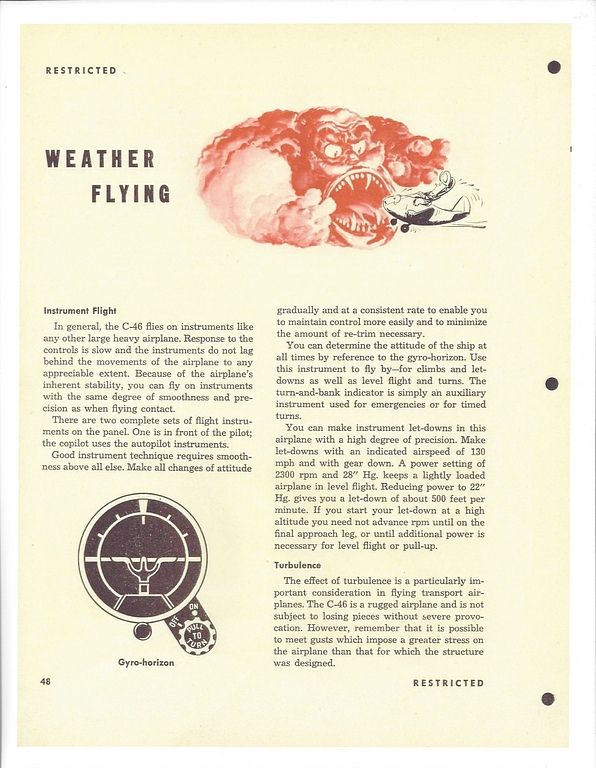
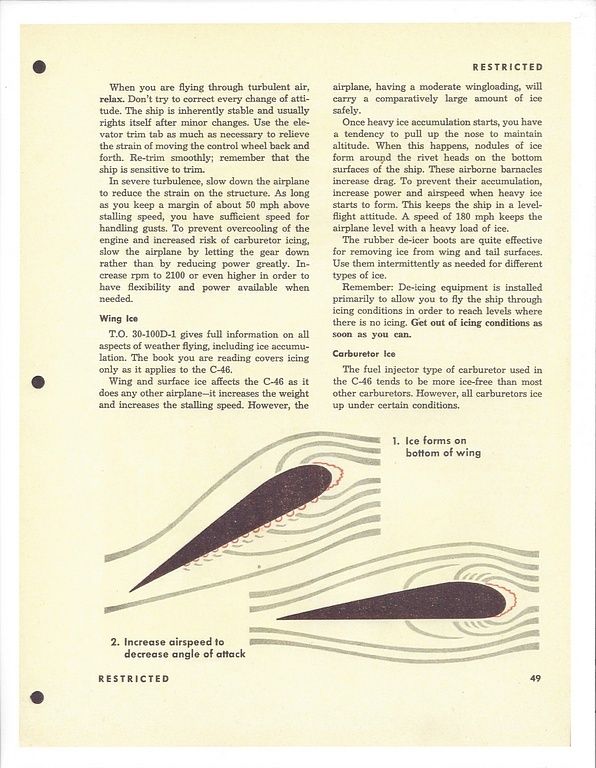
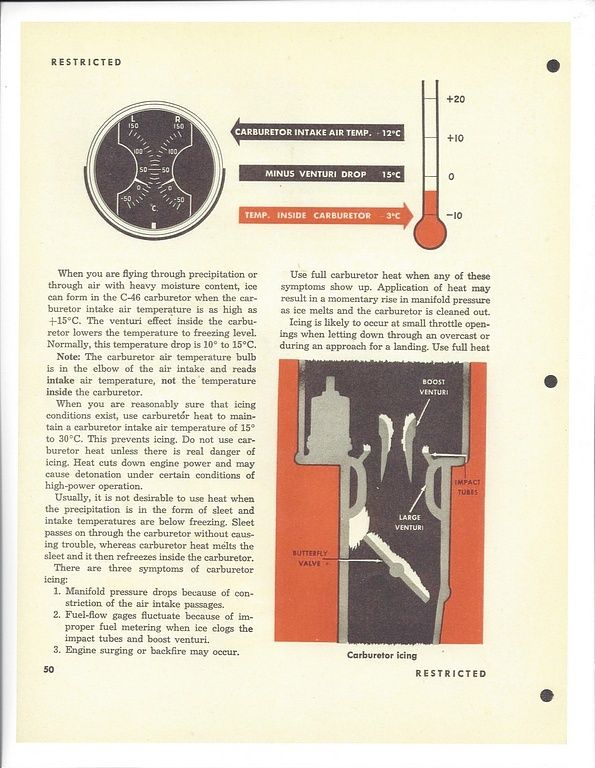
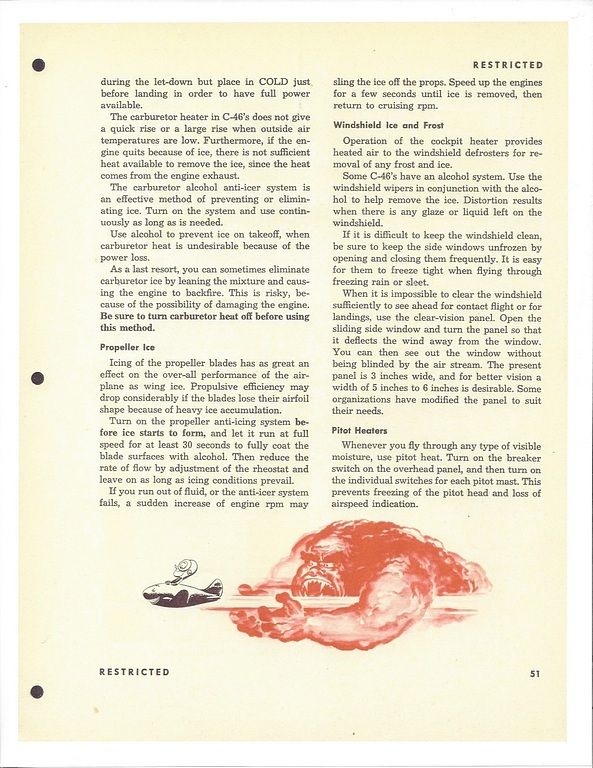
I did a bit more checking and found this in the C-46 Flight Manual
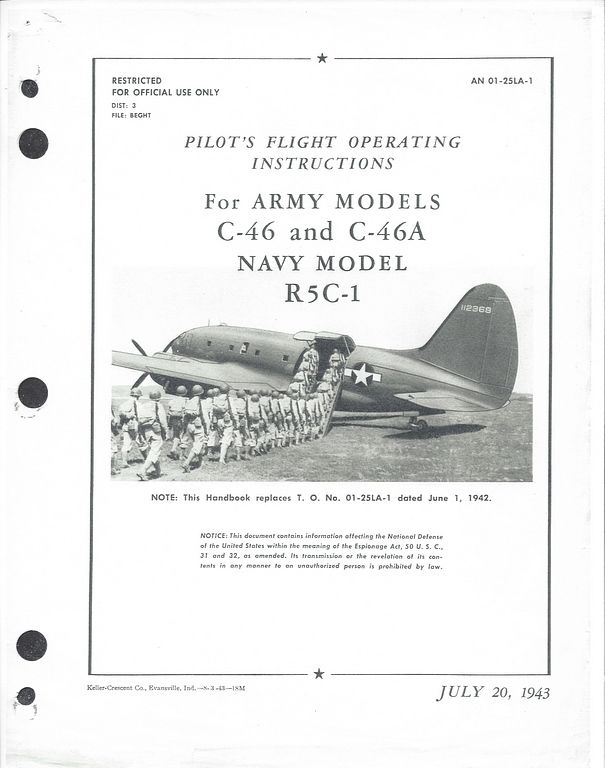






I did a bit more checking and found this in the C-46 Flight Manual


Re: "Carburetor icing" over the Hump possible?
Sat Apr 30, 2016 4:23 pm
Thank you, Larry, that's very helpful.
Re: "Carburetor icing" over the Hump possible?
Sat Apr 30, 2016 5:52 pm
My pleasure Stephan. I don't have any experience with R2800's, but induction system icing can be a problem even with the direct fuel injection R3350 engines on the DC-7 in certain weather conditions. We had to use the carburetor heat for considerable periods on every trip to Alaska via the coastal route. That said, the equivalent of a carburetor on the fuel injected R3350 is called a master control and no fuel is involved until it is injected directly into the cylinder. So, that would fall under the heading of impact icing, I suppose, although there was a drop in temperature inside the Venturi.
The main worry was having the impact tubes that sensed the airflow through the master control ice up. As that happened the apparent airflow would be less than the actual airflow and the master control would lean the mixture to compensate and that could eventually lead to a mixture that was too lean to allow the engine to continue running with no heat available to to melt the ice. The DC-7 had alcohol to deal with that originally, but our tankers had that, along with all other de-icing and anti-icing equipment removed as useless weight.
The high gross versions of Beech 18's with ram air scoops below the cowling are very susceptible to the conventional definition of carburetor icing when anywhere near freezing temperatures and fairly high humidity. Of course, the R985 has a conventional, if updraft carburetor. You could have an engine quit on that airplane if you were not paying attention. Again with no carburetor heat available to melt the ice if you let it go that far. I used to note the manifold pressure reading during cruise in those airplanes and then cycle the carburetor heat occasionally to see if the manifold pressure increased when removing the carb heat. If it did it was time to pay closer attention.
The main worry was having the impact tubes that sensed the airflow through the master control ice up. As that happened the apparent airflow would be less than the actual airflow and the master control would lean the mixture to compensate and that could eventually lead to a mixture that was too lean to allow the engine to continue running with no heat available to to melt the ice. The DC-7 had alcohol to deal with that originally, but our tankers had that, along with all other de-icing and anti-icing equipment removed as useless weight.
The high gross versions of Beech 18's with ram air scoops below the cowling are very susceptible to the conventional definition of carburetor icing when anywhere near freezing temperatures and fairly high humidity. Of course, the R985 has a conventional, if updraft carburetor. You could have an engine quit on that airplane if you were not paying attention. Again with no carburetor heat available to melt the ice if you let it go that far. I used to note the manifold pressure reading during cruise in those airplanes and then cycle the carburetor heat occasionally to see if the manifold pressure increased when removing the carb heat. If it did it was time to pay closer attention.
Re: "Carburetor icing" over the Hump possible?
Mon May 02, 2016 2:08 pm
This is why WIX is still worth coming back to, thanks guys.
Ken
Ken
Re: "Carburetor icing" over the Hump possible?
Tue May 03, 2016 3:38 pm
This is directed at Larry Kraus, but if anybody else knowledgeable has input, go for it.
From the 2011 book "The Hump," by John D. Plating, a former USAF transport pilot and currently a history prof at the Air Force Academy, though I doubt he has any large-recip time:
"Toward the end of [the C-54's] test period over the Hump, it began to encounter icing that choked its engines and caused them to fail in flight. The reason for this was not the airplane's lack of power to climb over the mountains but just the opposite. To cruise at 18,000 feet the airplane had to fly at a lower rpm than normal (or else burn excessive fuel), making it highly susceptible to failure in areas of moderate to severe icing. This was not a problem for the two-engine transports because they had to operate at a higher rpm to maintain altitude. The C-54's engines were not turbosupercharged and so could not outclimb the icing--but also could not fly at a lower altitude without the threat of engine failure."
Does this make sense to you? It doesn't to me.
From the 2011 book "The Hump," by John D. Plating, a former USAF transport pilot and currently a history prof at the Air Force Academy, though I doubt he has any large-recip time:
"Toward the end of [the C-54's] test period over the Hump, it began to encounter icing that choked its engines and caused them to fail in flight. The reason for this was not the airplane's lack of power to climb over the mountains but just the opposite. To cruise at 18,000 feet the airplane had to fly at a lower rpm than normal (or else burn excessive fuel), making it highly susceptible to failure in areas of moderate to severe icing. This was not a problem for the two-engine transports because they had to operate at a higher rpm to maintain altitude. The C-54's engines were not turbosupercharged and so could not outclimb the icing--but also could not fly at a lower altitude without the threat of engine failure."
Does this make sense to you? It doesn't to me.
Re: "Carburetor icing" over the Hump possible?
Tue May 03, 2016 5:25 pm
Ken wrote:This is why WIX is still worth coming back to, thanks guys.
Ken
Yup.
Still a few real gems here. I always appreciate Larry and his vast experience.
Thanks for sharing.
Re: "Carburetor icing" over the Hump possible?
Tue May 03, 2016 6:02 pm
I am not an engine guy at all and that last one makes no sense to ME !!
And thanks Larry for sharing! this is pretty cool.
Tom P.
And thanks Larry for sharing! this is pretty cool.
Tom P.
Re: "Carburetor icing" over the Hump possible?
Tue May 03, 2016 6:38 pm
Stephan Wilkinson wrote:This is directed at Larry Kraus, but if anybody else knowledgeable has input, go for it.
From the 2011 book "The Hump," by John D. Plating, a former USAF transport pilot and currently a history prof at the Air Force Academy, though I doubt he has any large-recip time:
"Toward the end of [the C-54's] test period over the Hump, it began to encounter icing that choked its engines and caused them to fail in flight. The reason for this was not the airplane's lack of power to climb over the mountains but just the opposite. To cruise at 18,000 feet the airplane had to fly at a lower rpm than normal (or else burn excessive fuel), making it highly susceptible to failure in areas of moderate to severe icing. This was not a problem for the two-engine transports because they had to operate at a higher rpm to maintain altitude. The C-54's engines were not turbosupercharged and so could not outclimb the icing--but also could not fly at a lower altitude without the threat of engine failure."
Does this make sense to you? It doesn't to me.
It does make sense. The two engines in the C-46 are working harder to make sufficient power for the load. That means they are running at a higher manifold pressure and higher cylinder and engine temperatures - all of which make icing less likely. The four engines on the C-54 in the same flight regime need to make less power, which means they will be operating at lower manifold pressures (more likely to ice) and running cooler (making it more likely to ice)
If you were to push the power up on the C-54, you may have less chance of icing, but the fuel consumption will go up out of proportion and you may not have the range to make it.
Re: "Carburetor icing" over the Hump possible?
Sat May 07, 2016 3:10 pm
My only practical experience with C-54s is one test flight in 1982 where my friend Jim Baughman let me steer the airplane around a bit. As far as the quotation from the book concerning icing problems with the C-54 flying over the Hump, it sounds more like impact icing rather than carburetor icing. I did a bit of research and found some interesting material in the C-54 Pilot Training Manual.
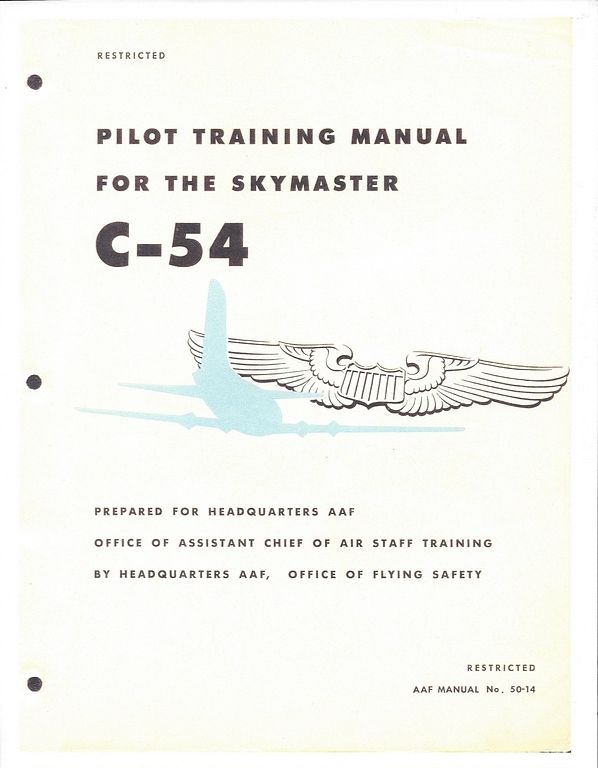
This page has a section on flying in turbulent air that is relevant to flying the Hump. Transport category aircraft are only usually only streesed for +2.5 Gs and -1 G, so flying in severe turbulence requires a special technique to prevent structural failure. That would be one reason for flying a lower airspeed. I don't know the G limits off hand for the C-46 and C-47, although I just checked in a Douglas Operations Manual from 1942 for a DC-3 and it shows a positive G limit of 2.5 at maximum gross weight, so they are probably the same as for the C-54.
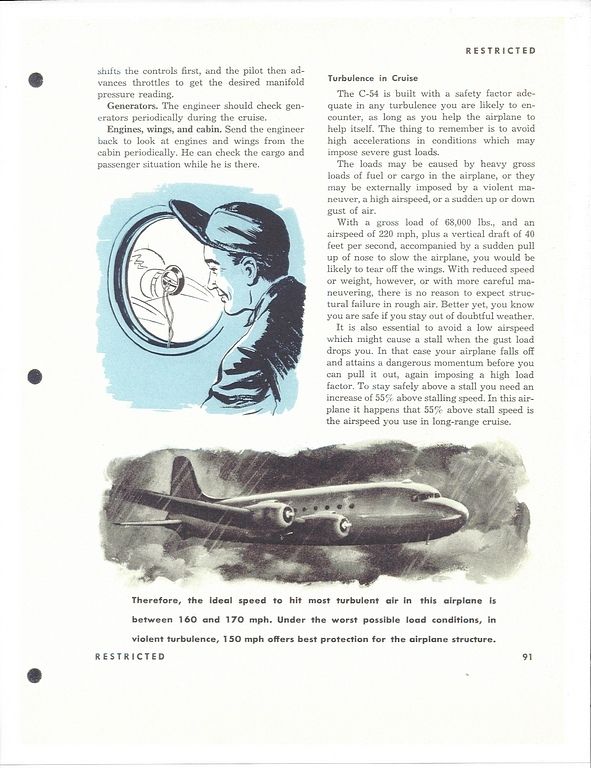
This page discusses the use of High Blower versus Low Blower. This is definitely a factor for flying the Hump. That said, the C-46 and C-47 would likely also have to use High Blower above 15,000 feet.
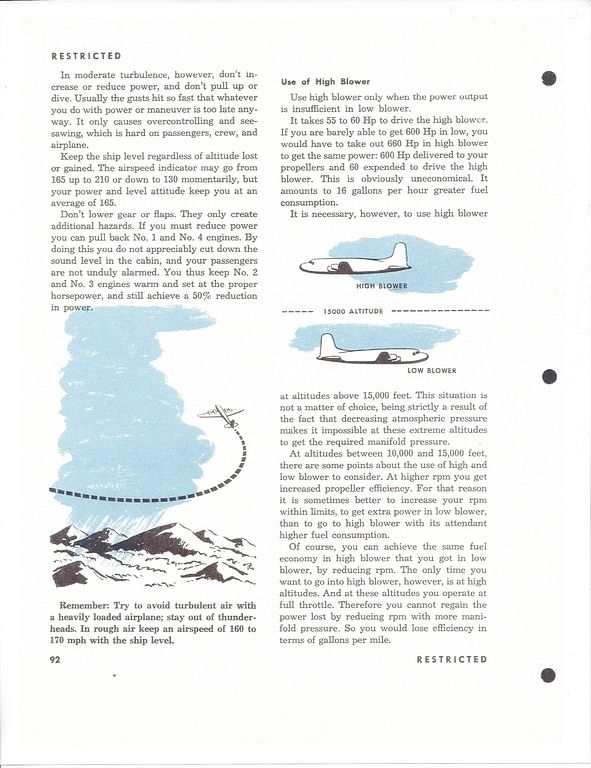
This page discusses the difficulty in recognizing that an engine has stopped developing power in a 4 engine airplane in cruise. It sounds ridiculous, but I can tell you from experience that an engine can run out of fuel or ice up and die and there would be no dramatic or obvious indications unless the airplane has BMEP indicators or Torquemeters. The manifold pressure will not change as long as the power setting is below ambient barometeric pressure. If boost is required, the failure would be more apparent. The RPM of the engine can be changed and it will operate normally. The first indication of a problem will be a minor decrease in indicated airspeed and lowering CHT and oil temp. Strange, but true. As a matter of fact, when I was in Northern Air Cargo's C-118 flight simulator a few years ago, the instructor tried to simulate a complete magneto failure in cruise, but I didn't recognize it as such because the engine would show a higher than barometric manifold pressur if I advanced the throttle. After discussing this with the instructor, he decided that the simulator was only a machine and not quite that sophisticated. It was state of the art for 1953 with IBM punch cards and vacuum tubes by the hundreds, if not thousands. An amazing machine, none the less.
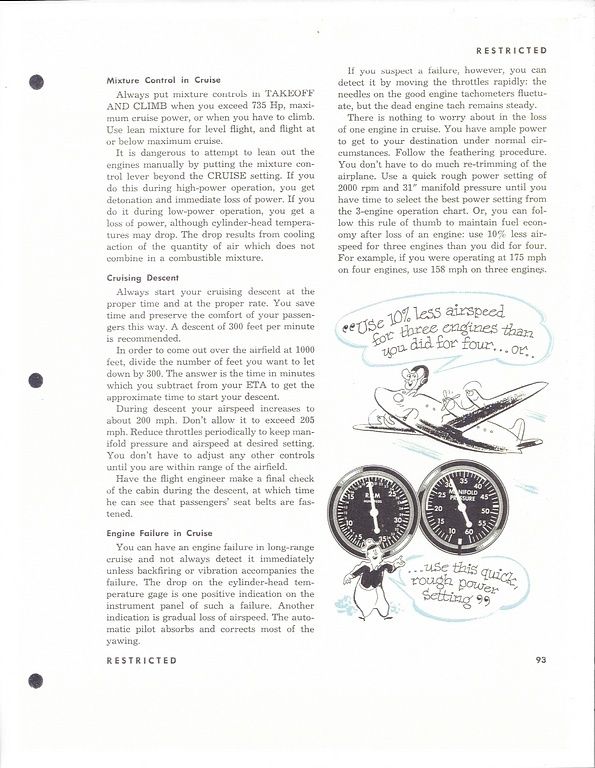
At the bottom of this page, there is a statement that seems difficult to believe about there being no authenticated cases of carburetor icing in C-54's. It does give the procedure for dealing with carb ice, however that is continued on the following page.
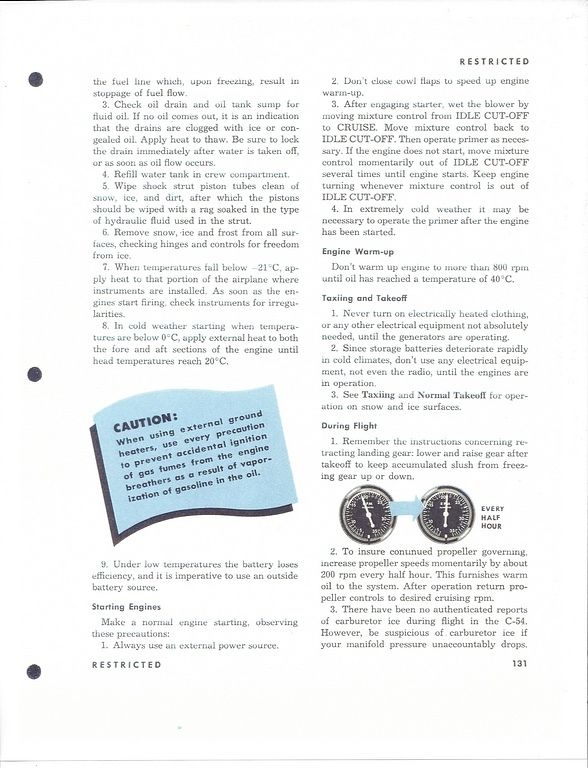
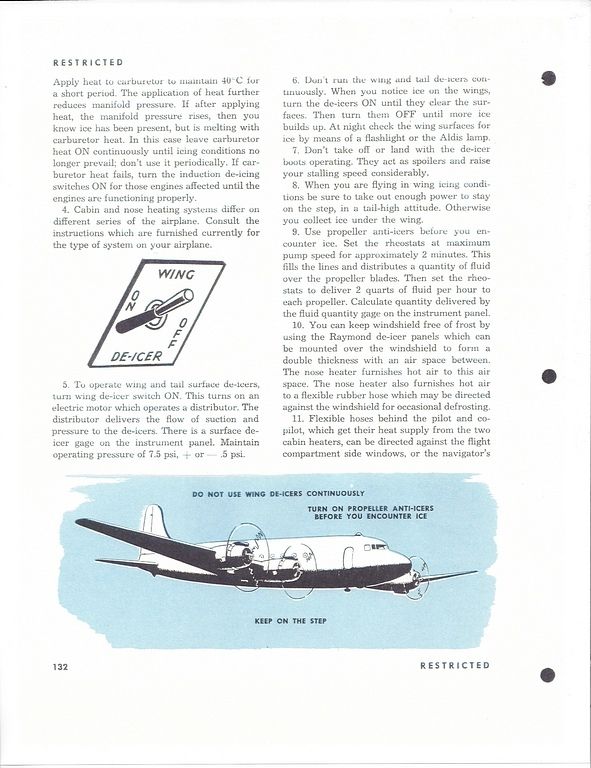
This also warns to "Keep on the step" when using the de-icers and anti-icers. This refers to recovering airspeed if the airplane enters a more nose high attitude when the systems are used. The normal procedure for leveling off at cruise altitude was to initially climb about 500 feet higher than the desired cruise altitude and the descend rapidly to the cruise altitude to gain a few extra knots. this airspeed would usually stabilize at a considerably higher number than if you levelled off as soon as cruise altitude was reached. I've met numerous little airplane flight instructors that will show me on the blackboard that this is a myth. Maybe so, but I know from experience that it works. It's pretty hard to get away with in the age of Mode C transponders, though.

This page has a section on flying in turbulent air that is relevant to flying the Hump. Transport category aircraft are only usually only streesed for +2.5 Gs and -1 G, so flying in severe turbulence requires a special technique to prevent structural failure. That would be one reason for flying a lower airspeed. I don't know the G limits off hand for the C-46 and C-47, although I just checked in a Douglas Operations Manual from 1942 for a DC-3 and it shows a positive G limit of 2.5 at maximum gross weight, so they are probably the same as for the C-54.

This page discusses the use of High Blower versus Low Blower. This is definitely a factor for flying the Hump. That said, the C-46 and C-47 would likely also have to use High Blower above 15,000 feet.

This page discusses the difficulty in recognizing that an engine has stopped developing power in a 4 engine airplane in cruise. It sounds ridiculous, but I can tell you from experience that an engine can run out of fuel or ice up and die and there would be no dramatic or obvious indications unless the airplane has BMEP indicators or Torquemeters. The manifold pressure will not change as long as the power setting is below ambient barometeric pressure. If boost is required, the failure would be more apparent. The RPM of the engine can be changed and it will operate normally. The first indication of a problem will be a minor decrease in indicated airspeed and lowering CHT and oil temp. Strange, but true. As a matter of fact, when I was in Northern Air Cargo's C-118 flight simulator a few years ago, the instructor tried to simulate a complete magneto failure in cruise, but I didn't recognize it as such because the engine would show a higher than barometric manifold pressur if I advanced the throttle. After discussing this with the instructor, he decided that the simulator was only a machine and not quite that sophisticated. It was state of the art for 1953 with IBM punch cards and vacuum tubes by the hundreds, if not thousands. An amazing machine, none the less.

At the bottom of this page, there is a statement that seems difficult to believe about there being no authenticated cases of carburetor icing in C-54's. It does give the procedure for dealing with carb ice, however that is continued on the following page.


This also warns to "Keep on the step" when using the de-icers and anti-icers. This refers to recovering airspeed if the airplane enters a more nose high attitude when the systems are used. The normal procedure for leveling off at cruise altitude was to initially climb about 500 feet higher than the desired cruise altitude and the descend rapidly to the cruise altitude to gain a few extra knots. this airspeed would usually stabilize at a considerably higher number than if you levelled off as soon as cruise altitude was reached. I've met numerous little airplane flight instructors that will show me on the blackboard that this is a myth. Maybe so, but I know from experience that it works. It's pretty hard to get away with in the age of Mode C transponders, though.
Re: "Carburetor icing" over the Hump possible?
Sat May 07, 2016 3:18 pm
I also found instructions for dealing with carburetor ice in a couple of C-54 Flight Manuals. The first is for the C-54A

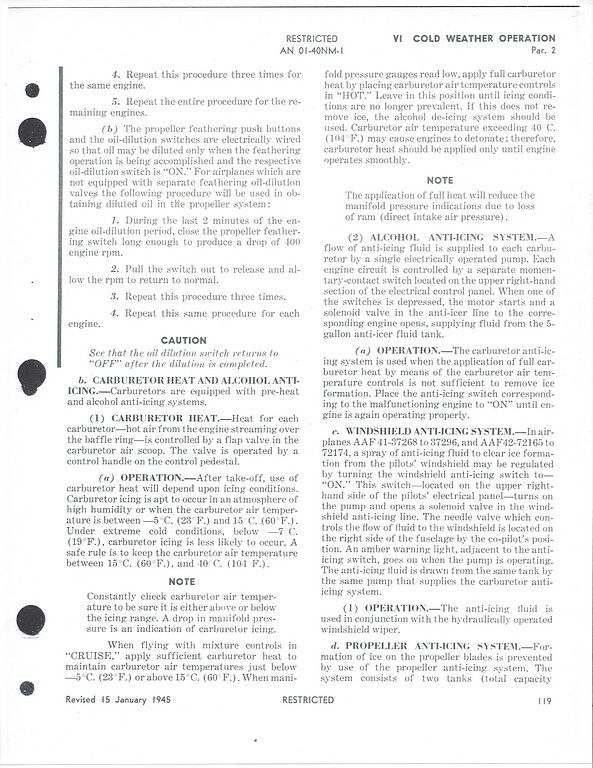
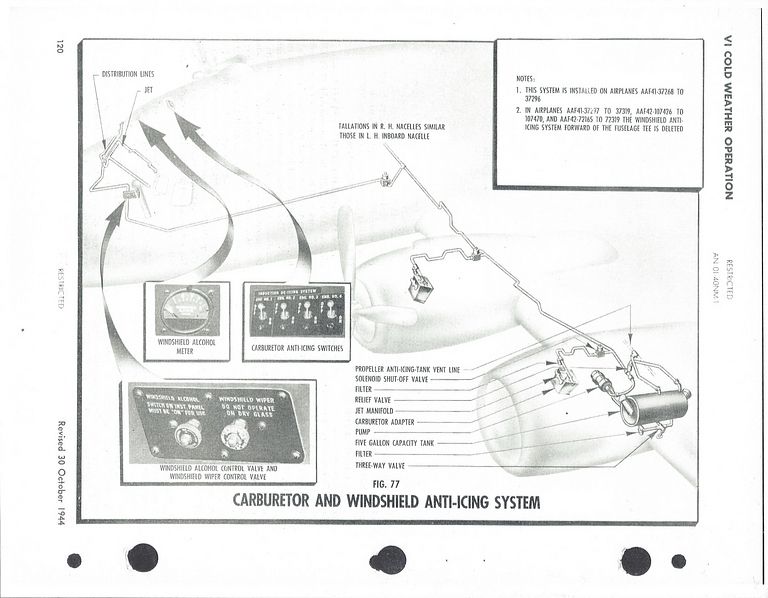
Here's what the C-54G manual says about it
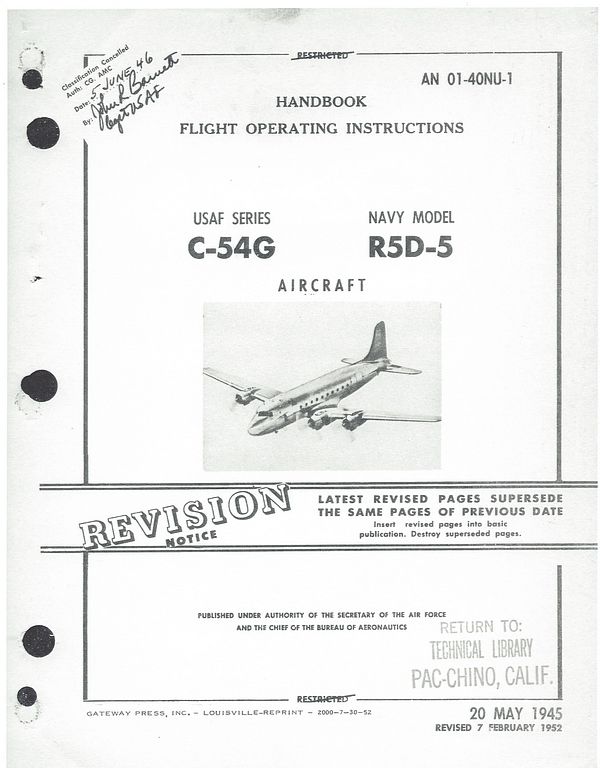
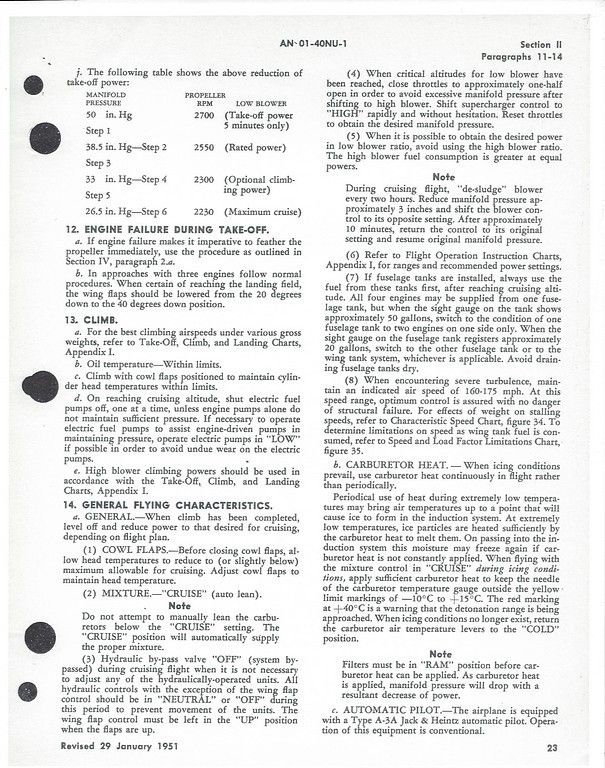



Here's what the C-54G manual says about it

